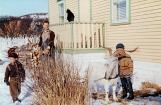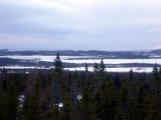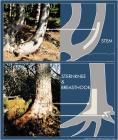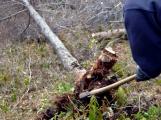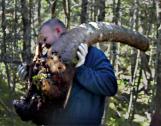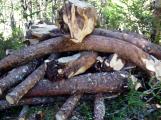1
Boat building students and their instructor2003
Winterton Boat Building and Community Museum, Newfoundland and Labrador, Canada
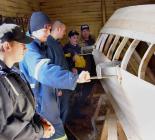
2
These students (left to right: Stephen Green, Andrew Green, Chad Ash, Chad Chislett, and instructor, Melvin Green) were instructed in the traditional Winterton methods of boat building in 2003, at the Winterton Boat Building and Community Museum. The project lasted six months and involved the students in all aspects of building a traditional motorboat. The boat they built is currently on display at the museum. The process began with tree selection in the woods near Winterton.This building and teaching project was assisted by Fred Green, and particularly Alfred Green, who at eighty-four years of age shared a lifetime of traditional boat building knowledge.
4
One of the primary reasons that Winterton became a prominent boat building community was the surrounding forest of spruce, fir, larch (locally called juniper) and birch, which provided all of the necessary building materials. Many communities located near good fishing grounds did not have such easy access to suitable timber.All Winterton boats were built using local trees, both white and black spruce, balsam fir, and juniper (larch or tamarack). Usually materials were gathered during late fall and early winter. The boats were then constructed in early spring to be ready for the next fishing season. Fir and spruce could be used interchangeably if the size and shape were correct.
6
There is clear evidence that boatbuilders learned and remembered mental pictures of hull shapes. They could go into the woods and without actual patterns find and cut trees that matched the hull shape for different parts of the boat. This practice continues to the present in Winterton.8
If the base of the tree is needed the surrounding earth is first removed. As much as possible of the selected root is left on the tree. The tree is then prepared by cutting off the unwanted roots, branches and the top section of the tree.10
When the excess parts of the tree are removed it is ready for lugging (carrying, usually on the shoulder) to a central location. If the timber piece was too heavy to be lugged, it would be dragged on the ground using ropes.12
Once the timber pieces were at a central location these would be stacked and left until the winter when the frozen bogs and ponds would make removal from the woods easier. New boats were usually built during this time as it was the off-season for the fishery.13
Goats were sometimes used to help pull out firewood or boat timber pieces1970
Winterton, Newfoundland, Canada
